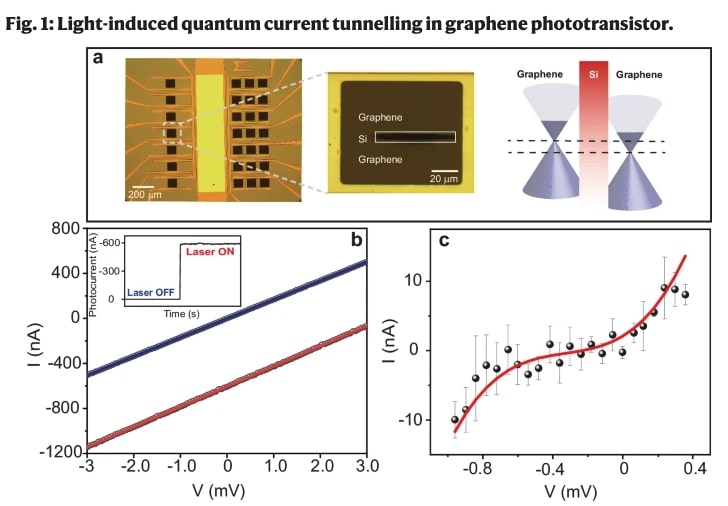Now Reading: World’s First Petahertz-speed Phototransistor at Room Temperature
-
01
World’s First Petahertz-speed Phototransistor at Room Temperature
World’s First Petahertz-speed Phototransistor at Room Temperature

Researchers demonstrated a way to manipulate electrons in graphene using pulses of light that last less than one thousands trillionth (one quadrillionth) of a second. By leveraging a quantum effect known as tunneling, they recorded electrons bypassing a physical barrier almost instantaneously, a feat that redefines the potential limits of computer processing power.
A study published in Nature Communications highlights how the technique could lead to processing speeds in the petahertz range – over 1,000 times faster than modern computer chips.

Nature Communications – Light-induced quantum tunnelling current in graphene
In the last decade, advancements in attosecond spectroscopy have allowed researchers to study and manipulate electron dynamics in condensed matter via ultrafast light fields, offering the possibility to realise ultrafast optoelectronic devices. Here, it is reported that the generation of light-induced quantum tunnelling currents in graphene phototransistors by ultrafast laser pulses in an ambient environment. This tunnelling effect provides access to an instantaneous field-driven current, demonstrating a current switching effect (ON and OFF) on a ~630 attosecond scale (~1.6 petahertz speed). They show the tunability of the tunnelling current and enhancement of the graphene phototransistor conductivity by controlling the density of the photoexcited charge carriers at different pump laser powers. They exploited this capability to demonstrate various logic gates. The reported approach under ambient conditions is suitable for the development of petahertz optical transistors, lightwave electronics, and optical quantum computers.
The development of ultrafast light tools is vital for studying light-matter interactions and related electron motion dynamics in real time. For instance, the generation of XUV attosecond pulses via high-harmonic generation in the solid-state permitted probing the strong field-induced electron dynamics in condensed matter. Recently, the generation of a single attosecond electron pulse and the development of attomicroscopy have given access to the bound electron dynamics in the nanostructure and connected it to its morphology. Moreover, the ability to manipulate and synthesis the waveform of ultrashort laser pulses allows for controlling the electronic motion, electronic structure, and physical properties of dielectric and semiconductor materials to demonstrate ultrafast optical switches. Furthermore, both optical and XUV pulses have been used to generate ultrafast current signals. These studies have found many applications, such as the demonstration of optical-based devices for sampling the ultrafast waveforms of light.
Recently, the generation of light-induced current (IL), based on photoexcitation of graphene’s carriers, has been reported.
In this work, they used a graphene-silicon-graphene (Gr-Si-Gr) phototransistor to generate sub-microamperes light-induced current (IL) by few-cycle laser pulses. In this transistor, the current flows based on quantum tunnelling between the graphene and the silicon junction. Hence, the generated current is gated in time, which allows us to access and record the ultrafast instantaneous field-induced current (IE). The IE modulates periodically in real-time, following the waveform of the driver field, enabling a current switching between two states (ON and OFF) with a time speed of 630 attoseconds (1.6 petahertz). They control the IL current amplitude by increasing the induction laser beam intensity and determine the consequent enhancement of our phototransistor photoconductivity. Finally, the flexibility of our transistor setup allowed us to combine a DC current (IV), generated by applying external voltage, with the IL, to demonstrate several logic gates within our phototransistor. Importantly, the presented experiments are performed under ambient standard temperature and pressure conditions, making this phototransistor at the technology readiness level for developing attosecond and lightwave quantum optoelectronics.
Sending data at those speeds would revolutionize computing as we know it, said Mohammed Hassan, an associate professor of physics and optical sciences. Hassan has long pursued light-based computer technology and previously led efforts to develop the world’s fastest electron microscope.
The team was originally studying the electrical conductivity of modified samples of graphene, a material composed of a single layer of carbon atoms. When a laser shines on graphene, the energy of the laser excites electrons in the material, making them move and form into a current.
Sometimes, those electric currents cancel each other out. Hassan said this happens because the laser’s energy wave moves up and down, generating equal and opposite currents on either side of the graphene. Because of graphene’s symmetrical atomic structure, these currents mirror each other and cancel each other out, leaving no detectable current.
But what if a single electron could slip through the graphene, and its journey could be captured and tracked in real time? That near-instant “tunnelling” was the unexpected result of the team modifying different graphene samples.
“That is what I love most about science: The real discovery comes from the things you don’t expect to happen,” Hassan said. “Going into the lab, you always anticipate what will happen – but the real beauty of science are the little things that happen, which lead you to investigate more. Once we realized that we had achieved this tunneling effect, we had to find out more.”
Using a commercially available graphene phototransistor that was modified to introduce a special silicon layer, the researchers used a laser that switches off and on at a rate of 638 attoseconds to create what Hassan called “the world’s fastest petahertz quantum transistor.”
A transistor is a device that acts as an electronic switch or amplifier that controls the flow of electricity between two points and is fundamental to the development of modern electronics.
“For reference, a single attosecond is one-quintillionth of a second,” Hassan said. “That means that this achievement represents a big leap forward in the development of ultrafast computer technologies by realizing a petahertz-speed transistor.”
While some scientific advancements occur under strict conditions, including temperature and pressure, this new transistor performed in ambient conditions – opening the way to commercialization and use in everyday electronics.

Brian Wang is a Futurist Thought Leader and a popular Science blogger with 1 million readers per month. His blog Nextbigfuture.com is ranked #1 Science News Blog. It covers many disruptive technology and trends including Space, Robotics, Artificial Intelligence, Medicine, Anti-aging Biotechnology, and Nanotechnology.
Known for identifying cutting edge technologies, he is currently a Co-Founder of a startup and fundraiser for high potential early-stage companies. He is the Head of Research for Allocations for deep technology investments and an Angel Investor at Space Angels.
A frequent speaker at corporations, he has been a TEDx speaker, a Singularity University speaker and guest at numerous interviews for radio and podcasts. He is open to public speaking and advising engagements.























